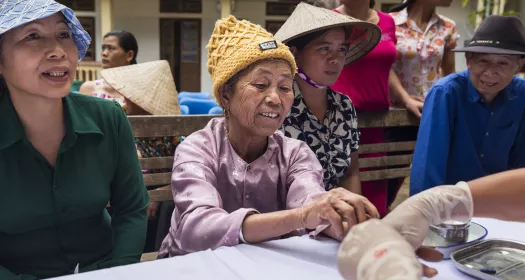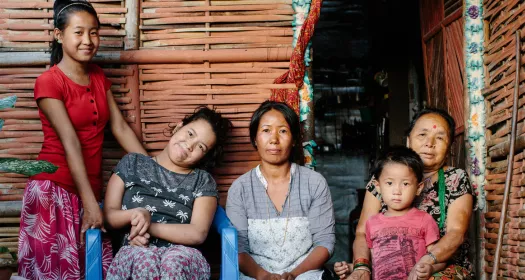Media Library
icon
-
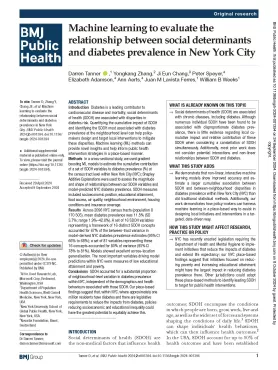 PDFlockPopulation Health / PublicationMachine learning to evaluate the relationship between social determinants and diabetes prevalence in New York CityDiabetes is a leading contributor to cardiovascular disease and mortality; social determinants of health (SDOH) are associated with disparities in diabetes risk. Quantifying the cumulative impact of SDOH and identifying the SDOH most associated with diabetes prevalence at the neighborhood level can help policy-makers design and target local interventions to mitigate these disparities. Machine learning (ML) methods can provide novel insights and help inform public health intervention strategies in a place-based manner. In a cross-sectional study, we used gradient boosting ML models to estimate the cumulative contribution of a set of SDOH variables to diabetes prevalence (%) at the census tract level within New York City (NYC); Shapley Additive Explanations were used to assess the magnitude and shape of relationships between our SDOH variables and model-predicted NYC diabetes prevalence. SDOH measures included socioeconomic position, educational attainment, food access, air quality, neighbourhood environment, housing conditions and insurance coverage.
PDFlockPopulation Health / PublicationMachine learning to evaluate the relationship between social determinants and diabetes prevalence in New York CityDiabetes is a leading contributor to cardiovascular disease and mortality; social determinants of health (SDOH) are associated with disparities in diabetes risk. Quantifying the cumulative impact of SDOH and identifying the SDOH most associated with diabetes prevalence at the neighborhood level can help policy-makers design and target local interventions to mitigate these disparities. Machine learning (ML) methods can provide novel insights and help inform public health intervention strategies in a place-based manner. In a cross-sectional study, we used gradient boosting ML models to estimate the cumulative contribution of a set of SDOH variables to diabetes prevalence (%) at the census tract level within New York City (NYC); Shapley Additive Explanations were used to assess the magnitude and shape of relationships between our SDOH variables and model-predicted NYC diabetes prevalence. SDOH measures included socioeconomic position, educational attainment, food access, air quality, neighbourhood environment, housing conditions and insurance coverage. -
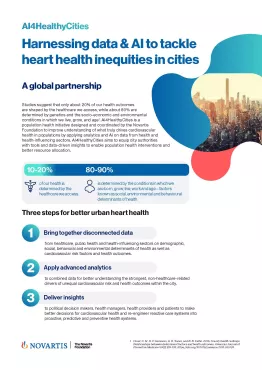 PDFlockPopulation Health / InfographicAI4HealthyCities Media Background MaterialThis document provides a more detailed overview of the Novartis Foundation’s AI4HealthyCities population health approach, both on a global scale and for the New York City program. It explains the science behind the approach, outlines city goals, mentions local partners in New York City, and offers potential patient personas as well as maps that visualize the distribution of social determinants of health potentially contributing to cardiovascular health across town. © 2024 The Novartis Foundation
PDFlockPopulation Health / InfographicAI4HealthyCities Media Background MaterialThis document provides a more detailed overview of the Novartis Foundation’s AI4HealthyCities population health approach, both on a global scale and for the New York City program. It explains the science behind the approach, outlines city goals, mentions local partners in New York City, and offers potential patient personas as well as maps that visualize the distribution of social determinants of health potentially contributing to cardiovascular health across town. © 2024 The Novartis Foundation -
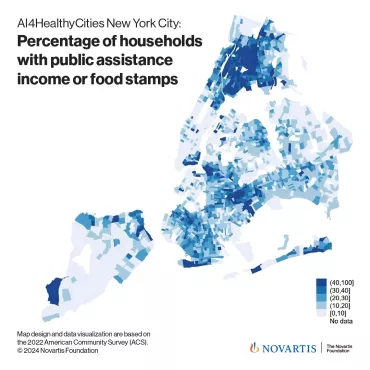 ImagelockPopulation HealthAI4HealthyCities New York City – SDOH Public Assistance Income SNAPThis map of New York City shows the percentage of households with public assistance income or reliance on food stamps across census tracts, a potential driver of heart health outcomes in the city. Map design and data visualization are based on the 2022 American Community Survey (ACS). © 2024 The Novartis Foundation
ImagelockPopulation HealthAI4HealthyCities New York City – SDOH Public Assistance Income SNAPThis map of New York City shows the percentage of households with public assistance income or reliance on food stamps across census tracts, a potential driver of heart health outcomes in the city. Map design and data visualization are based on the 2022 American Community Survey (ACS). © 2024 The Novartis Foundation -
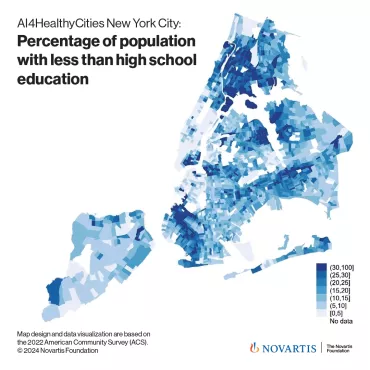 ImagelockPopulation HealthAI4HealthyCities New York City – SDOH Education LevelsThis map of New York City shows the percentage of population with less than high school education across census tracts, a potential driver of heart health outcomes in the city. Map design and data visualization are based on the 2022 American Community Survey (ACS). © 2024 The Novartis Foundation
ImagelockPopulation HealthAI4HealthyCities New York City – SDOH Education LevelsThis map of New York City shows the percentage of population with less than high school education across census tracts, a potential driver of heart health outcomes in the city. Map design and data visualization are based on the 2022 American Community Survey (ACS). © 2024 The Novartis Foundation -
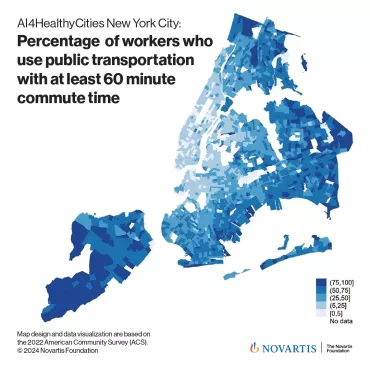 ImagelockPopulation HealthAI4HealthyCities New York City – SDOH CommutingThis map of New York City shows the percentage of workers with daily commutes of at least 60 minutes on public transport across census tracts, a potential driver of heart health outcomes in the city. Map design and data visualization are based on the 2022 American Community Survey (ACS). © 2024 The Novartis Foundation
ImagelockPopulation HealthAI4HealthyCities New York City – SDOH CommutingThis map of New York City shows the percentage of workers with daily commutes of at least 60 minutes on public transport across census tracts, a potential driver of heart health outcomes in the city. Map design and data visualization are based on the 2022 American Community Survey (ACS). © 2024 The Novartis Foundation -
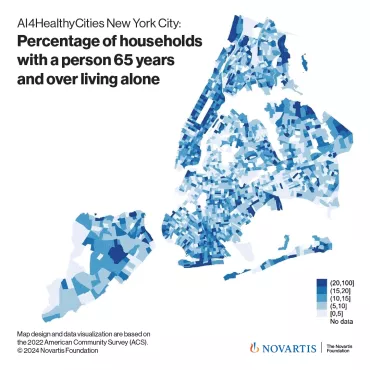 ImagelockPopulation HealthAI4HealthyCities New York City – SDOH Living Alone 65+This map of New York City shows the prevalence of households with a person 65 years and over living alone across census tracts, a potential driver of heart health outcomes in the city. Map design and data visualization are based on the 2022 American Community Survey (ACS). © 2024 The Novartis Foundation
ImagelockPopulation HealthAI4HealthyCities New York City – SDOH Living Alone 65+This map of New York City shows the prevalence of households with a person 65 years and over living alone across census tracts, a potential driver of heart health outcomes in the city. Map design and data visualization are based on the 2022 American Community Survey (ACS). © 2024 The Novartis Foundation -
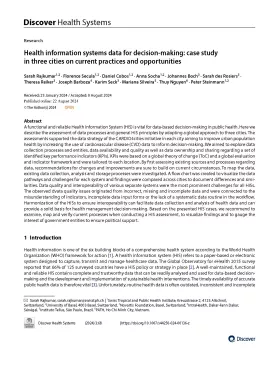 PDFlockPopulation Health / PublicationHealth information systems data for decision‑making: case study in three cities on current practices and opportunitiesA functional and reliable Health Information System (HIS) is vital for data-based decision-making in public health. The paper describes the assessment of data processes and general HIS principles by adapting a global approach to three cities. The assessments supported the data strategy of the CARDIO4Cities initiative in each city aiming to improve urban population health by increasing the use of cardiovascular disease (CVD) data to inform decision-making.
PDFlockPopulation Health / PublicationHealth information systems data for decision‑making: case study in three cities on current practices and opportunitiesA functional and reliable Health Information System (HIS) is vital for data-based decision-making in public health. The paper describes the assessment of data processes and general HIS principles by adapting a global approach to three cities. The assessments supported the data strategy of the CARDIO4Cities initiative in each city aiming to improve urban population health by increasing the use of cardiovascular disease (CVD) data to inform decision-making. -
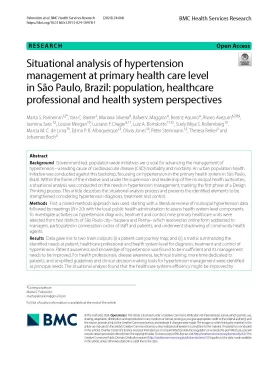 PDFlockPopulation Health / PublicationSituational analysis of hypertension management at primary health care level in São Paulo, Brazil: population, healthcare professional and health system perspectivesGovernment-led, population-wide initiatives are crucial for advancing the management of hypertension − a leading cause of cardiovascular disease (CVD) morbidity and mortality. An urban population health initiative was conducted against this backdrop, focussing on hypertension in the primary health system in São Paulo, Brazil. Within the frame of the initiative and under the supervision and leadership of the municipal health authorities, a situational analysis was conducted on the needs in hypertension management, marking the first phase of a Design Thinking process. This article describes the situational analysis process and presents the identified elements to be strengthened considering hypertension diagnosis, treatment and control.
PDFlockPopulation Health / PublicationSituational analysis of hypertension management at primary health care level in São Paulo, Brazil: population, healthcare professional and health system perspectivesGovernment-led, population-wide initiatives are crucial for advancing the management of hypertension − a leading cause of cardiovascular disease (CVD) morbidity and mortality. An urban population health initiative was conducted against this backdrop, focussing on hypertension in the primary health system in São Paulo, Brazil. Within the frame of the initiative and under the supervision and leadership of the municipal health authorities, a situational analysis was conducted on the needs in hypertension management, marking the first phase of a Design Thinking process. This article describes the situational analysis process and presents the identified elements to be strengthened considering hypertension diagnosis, treatment and control. -
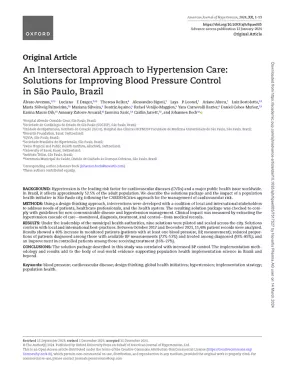 PDFlockPopulation Health / PublicationAn Intersectoral Approach to Hypertension Care: Solutions for Improving Blood Pressure Control in São Paulo, BrazilHypertension is the leading risk factor for cardiovascular diseases (CVDs) and a major public health issue worldwide. In Brazil, it affects approximately 52.5% of the adult population. We describe the solutions package and the impact of a population health initiative in São Paulo city, following the CARDIO4Cities approach for the management of cardiovascular risk.
PDFlockPopulation Health / PublicationAn Intersectoral Approach to Hypertension Care: Solutions for Improving Blood Pressure Control in São Paulo, BrazilHypertension is the leading risk factor for cardiovascular diseases (CVDs) and a major public health issue worldwide. In Brazil, it affects approximately 52.5% of the adult population. We describe the solutions package and the impact of a population health initiative in São Paulo city, following the CARDIO4Cities approach for the management of cardiovascular risk. -
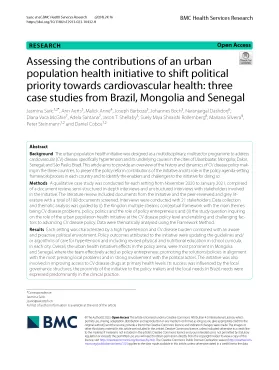 PDFlockPopulation Health / PublicationAssessing the contributions of an urban population health initiative to shift political priority towards cardiovascular healthAssessing the contributions of an urban population health initiative to shift political priority towards cardiovascular health: three case studies from Brazil, Mongolia and Senegal
PDFlockPopulation Health / PublicationAssessing the contributions of an urban population health initiative to shift political priority towards cardiovascular healthAssessing the contributions of an urban population health initiative to shift political priority towards cardiovascular health: three case studies from Brazil, Mongolia and Senegal -
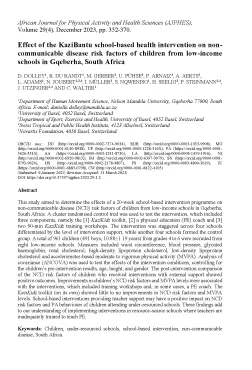 PDFlockPopulation Health / PublicationEffect of the KaziBantu school-based health intervention on NCDsEffect of the KaziBantu school-based health intervention on NCDs
PDFlockPopulation Health / PublicationEffect of the KaziBantu school-based health intervention on NCDsEffect of the KaziBantu school-based health intervention on NCDs -
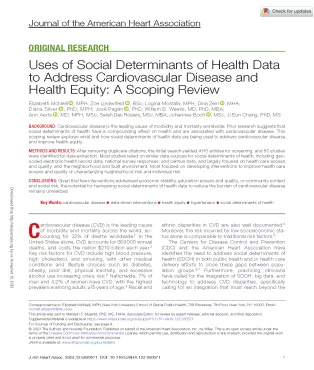 PDFlockPopulation Health / PublicationUses of social determinants of health data to address CVD and Health EquityUses of social determinants of health data to address CVD and Health Equity
PDFlockPopulation Health / PublicationUses of social determinants of health data to address CVD and Health EquityUses of social determinants of health data to address CVD and Health Equity


